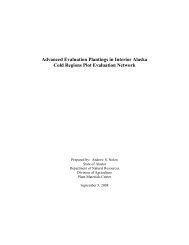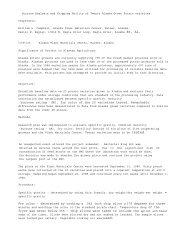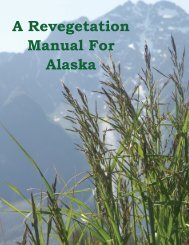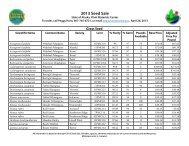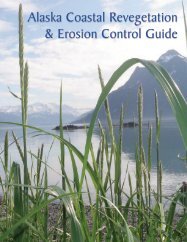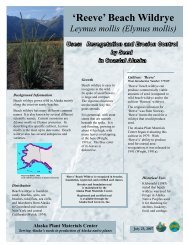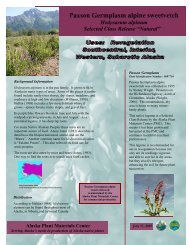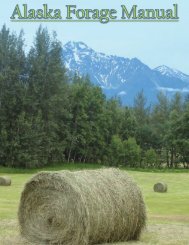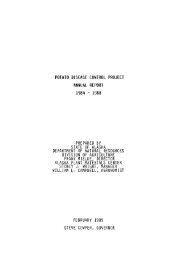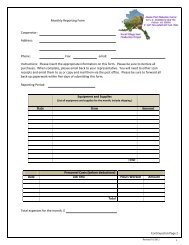Alaska Forage Manual - Alaska Plant Materials Center - State of ...
Alaska Forage Manual - Alaska Plant Materials Center - State of ...
Alaska Forage Manual - Alaska Plant Materials Center - State of ...
Create successful ePaper yourself
Turn your PDF publications into a flip-book with our unique Google optimized e-Paper software.
RED CLOVER<br />
<strong>Forage</strong> Value<br />
Red Clover can produce high yields and is excellent forage for<br />
all classes <strong>of</strong> livestock and wildlife. Depending on season <strong>of</strong><br />
harvest, protein content <strong>of</strong> 15-25% is common. Digestibility<br />
and relative feed value start high, but decline with plant<br />
maturity. Caution should be taken when feeding Trifolium<br />
pratense to animals due to the possibility <strong>of</strong> bloat.<br />
Distribution and Adaptation<br />
Photo: Michael Apel (Wikimedia.org)<br />
Red Clover<br />
Trifolium pratense (L.)<br />
Description<br />
Red Clover, Trifolium pratense<br />
Trifolium pratense, Red Clover is a short lived perennial or<br />
biennial legume. It grows erect to decumbent culms that are<br />
hairy and hollow. Each leaf consists <strong>of</strong> a slender stalk which is<br />
petiolated and bearing 3 leaflets, which are oblong to obovate<br />
(ovalish shape). Red Clover produces numerous flowers borne<br />
in compact clusters that are reddish to pink in color. There<br />
are two types <strong>of</strong> Red Clover that are commonly referred to as<br />
Medium and Mammoth. Medium Red Clover ranges in height<br />
from 45 - 60 centimeters (18 to 24 inches), while Mammoth<br />
Red Clover reaches an average height <strong>of</strong> 75 centimeters (30<br />
inches). Red Clover grows a series <strong>of</strong> lateral roots with a<br />
tap root that is extensively branched. This legume produces<br />
a small kidney shaped seed that is yellow to deep violet in<br />
color. Red clover has high seedling vigor and produces roughly<br />
270,000 seeds per pound <strong>of</strong> seed.<br />
Uses<br />
Livestock: Red Clover is typically used for hay, pastureland,<br />
and/or silage. It produces high quality forage that is palatable<br />
to all classes <strong>of</strong> livestock.<br />
Wildlife: Red Clover is highly palatable to large grazing and<br />
browsing animals such as deer, elk and bison. It is also utilized<br />
as food and cover by small mammals, waterfowl, and upland<br />
game birds.<br />
Red Clover is adapted to a variety <strong>of</strong> soils types but grows<br />
best in well drained loamy soils. It can be found growing<br />
throughout the United <strong>State</strong>s and Canada. Red Clover prefers<br />
a pH <strong>of</strong> 5.5 to 7.5 and has low drought tolerance. This legume<br />
can tolerate high moisture environments and has a moderate<br />
to low shade tolerance.<br />
Culture<br />
Red Clover should be planted at ¼ to ½ inch deep in well<br />
drained loamy to silt loam soils that have a high water holding<br />
capacity. It should be inoculated with the appropriate rhizobium<br />
innoculant, as this will help with plant establishment and<br />
seedling vigor. When seeded alone in pure stands, Red Clover<br />
should be drill seeded at a rate <strong>of</strong> 6-12 lbs/acre and 20-25 lbs/<br />
acre when broadcast seeding. Red Clover can also be seeded<br />
in mixtures with small grains or grasses like Barley (Hordeum<br />
vulgare), Timothy (Phleum pratense), and Smooth Brome<br />
(Bromus inermis). Standard seeding rates when seeded in a<br />
mix is 4-8 lbs/acre. All seeding rates are determined by using<br />
Pure Live Seed (PLS) calculations, as described in Appendix B.<br />
Appropriate fertilizer ratios depend upon soil type, chemistry,<br />
and location. Soil samples should be collected and analyzed<br />
before fertilizer is applied. Phosphorus is used in large<br />
quantities by Red Clover, which is a limiting factor on most soils.<br />
Pastures and hay fields should be irrigated when necessary<br />
and/or applicable. Irrigation in combination with fertilization<br />
should increase overall yields.<br />
Management<br />
Red Clover makes an excellent pasture, hay, or silage forage.<br />
It should be harvested ¼ to ½ in bloom during the first cutting.<br />
Successive grazing or a second cutting should occur when the<br />
legume is ¼ <strong>of</strong> the way into bloom stage, and at least 2 inches<br />
<strong>of</strong> growth should remain after harvest. Red Clover responds<br />
well to fertilizers and should be supplied with ample amounts<br />
<strong>of</strong> phosphorus and/or potash. Red Clover also responds well<br />
to irrigation when planted in moderate to well drained soils.<br />
When growing Red Clover, one should monitor for powdery<br />
mildew in areas <strong>of</strong> high humidity and/or rainfall. Resistant<br />
cultivars have been developed to reduce the occurrence <strong>of</strong><br />
these pests.<br />
77



